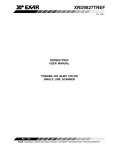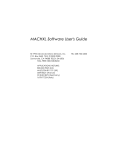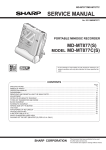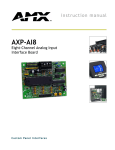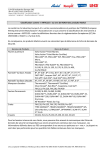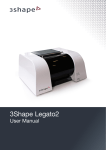Download Canon XRD9829REF User manual
Transcript
July 1998-2 XRD9829REF USER MANUAL CIS 30-BIT COLOR SINGLE LINE SCANNER EXAR Corporation, 48720 Kato Road, Fremont, CA 94538 • (510) 668-7000 • FAX (510) 668-7017 XRD9829REF EVALUATION KIT PART LIST This kit contains the following: • • • • • XRD9829REF CIS 30-Bit Color Single Line Scanner XRD9829REF User Manual ScanIt 1.0 Software Installation Diskettes (2) XRD9829 Data Sheet Scan Targets (Black, White, Color) FEATURES • • • • • One line scanning functionality of XRD9829 with CANON 300 DPI CIS Easy use with most personal computers through Parallel Port Interface Simple way of loading the Serial Port of XRD9829 to adjust gain and offset Software ScanIt to view single line scan Optimized Layout with Four Layers SYSTEM REQUIREMENTS • • • • Intel 486 compatible computer with Windows 95 operating system 8 MBytes system memory 25-pin D-shape parallel port receptacles 3 1/2” floppy disk drive INTRODUCTION The XRD9829REF is a demo system which includes a PCB design with a CANON CWB30216G 300 DPI Color Contact Image Sensor (CIS). It demonstrates how to interface a CIS with EXAR’s XRD9829, a 10-bit Linear CIS/CCD Sensor Signal Processor to get a single line scan. The XRD9829REF is designed to provide a signal path for the CIS output signals to be processed, digitized by the XRD9829 and transmitted to a personal computer. There are no software algorithms or hardware implementations to adjust for true color response. The XRD9829REF board is loaded with the XRD9829, a Vantis MACH435, two FIFO SRAMs and peripheral circuits for the CIS. The MACH435, which is a CMOS Programmable Logic Device (CPLD) provides timing signals to the XRD9829, the SRAMs and the CIS. It also programs the XRD9829 to operate in the correct mode and adjust for gain and offset values. The XRD9829 processes the analog output from the CIS sensor, level-shifts and converts the signal into digital codes. The SRAMs gate the digitized data from the XRD9829 and stores the data temporarily. Controlled by the software, the SRAMs send the data through a parallel port connection to the PC and histograms of raw data are displayed in the monitor using the ScanIt software. A block diagram of the XRD9829REF is shown below in Figure 1. Rev. 1.00 2 XRD9829REF DATA FLIPFLOP DATA FIFO SRAM CANON CWB-30216G 300DPI COLOR CIS CIS OUTPUT XRD9829 PARALLEL PORT DB25 CONNECTOR 5-BIT BUS NIBBLE DATA 1.25V DC FLIPFLOP DATA FIFO SRAM INTEL 486 Compatible DATA XRD9829 CONTROL SIGNALS MACH435 CPLD CIS CONTROL SIGNALS PARALLEL PORT CONTROL Figure 1. Block Diagram of XRD9829REF The XRD9829 is a complete linear CIS or CCD sensor signal processor on a single monolithic chip. The XRD9829 includes a high speed 10-Bit ADC, a 6-Bit Programmable Gain Amplifier with gain adjustment of 1 to 10 and an 8-Bit programmable input referred offset calibration range of 800 mV. See the XRD9829EVAL User Manual / PCB board for evaluating the XRD9829 CIS / CCD signal processor chip. Rev. 1.00 3 XRD9829REF AVDD Power Down VIN0 VIN1 4-1 VIN2 DVDD + MUX VREF+ VRT BUFFER VIN3 _ V RL PGA 10-BIT 10 ADC V DCREF DCEXT INT/EXT_V DATA OUT PORT DB4:0 / DB9:5 VRB DCREF 6 CLP G<5:0> DGND 6-BIT GAIN REGISTER MUX SEL 5 Power Down DC/AC 8-BIT DAC AVDD AGND AGND AGND 8 O<7:0> CIS/CCD 8-BIT OFFSET REGISTER VRT CCD CIS CONTROL LOGIC ADCCLK PDB SCLK SDATA LD Figure 2. Functional Block Diagram of XRD9829 OPERATIONAL PROCEDURE The routine listed below will first calibrate the photo response of the CIS using the XRD9829. After calibration, the XRD9829REF can be used to scan any color target to show CIS non-color corrected response. (Color correction is typically done in the digital asic.) How to Run the XRD9829REF Demonstration: 1. Make sure the computer is powered off and the AC power adapter is disconnected from a wall outlet 2. Connect the parallel port cable to the printer port of the computer 3. Connect the AC power adapter into a wall outlet 4. Turn on the computer and activate Windows 95 Loading EXAR Software 5. 6. 7. 8. Load the diskette labeled ScanIt 1.0 Disk # 1 into the floppy drive Select the Start menu in the program manager and choose RUN Inside the small pop-up window, type: A:\setup Follow the instructions to finish software installation Rev. 1.00 4 XRD9829REF Parallel Port Configurations 9. Confirm the parallel port address as follows: a. b. c. d. e. f. g. h. i. j. Select the Start Menu, choose Settings, then choose Control Panel From the Control Panel window which pops up, double-click on System In the System Properties window, select Device Manager From the Device Manager window, double-click on Ports (COM & LPT) Double-click on Printer Port (LPT1). If you can not find it, please goto Step 10 From the pop-up window, select Resources Verify the Input/Output Range is set to 0378 - 037F If the range is not correct, clear the Use Automatic Settings check box by clicking it Choose correct address which is 0378 by default and click OK Re-start the computer as advised 10. If you do not have a Printer Port configured on your computer, please follow the steps listed below: a. b. c. d. e. f. g. h. From the Control Panel window which pops up, double-click on Add New Hardware From the pop-up window, click the Next > button Select ‘No’ when prompted for ‘Do you want Windows to search for your new hardware?’, then click the Next > button Choose Ports (COM & LPT), then click the Next > button Choose Printer Port, then click the Next > button Make a note of the Input/Output Range of Printer Port of your computer and click OK. You will use these values later when configure the ScanIt software Re-start the computer as advised Offset Adjustment With a Black Target 11. Set the dip switches located on the side panel of the scanner to 1100010000 as shown in Figure 2 and push the Serial Port button which is located on the front panel of the demo system. This will reset the XRD9829. Rev. 1.00 5 XRD9829REF S 1 S 0 D D D D D D D D 7 6 5 4 3 2 1 0 1 0 Figure 3. Dip Switches Set to Value 1100010000 to Reset the XRD9829 Rev. 1.00 6 XRD9829REF Control Registers Function D7 D6 D5 D4 D3 D2 D1 D0 Power-up (Register State S1/S0) (Note 1) Gain (00) G5 G4 G3 G2 G1 G0 X (MSB) X 000000XX (LSB) Offset O7 (01) (MSB) Mode X O6 O5 O4 O3 O2 O1 O0 01000000 X VRT INPUT DC DC/AC CIS/CCD MUX SEL MUX SEL XX000000 0: INTERNAL REFERENCE 0: DC 0: CIS 1: EXTERNAL (VDCREF) 1: AC 1: CCD X XXX0000X (LSB) (10) 0:INTERNAL 0 0: VIN0 0 0: VIN0 (VDCREF= AGND) 0 1: VIN1 1 0: VIN2 0 1: VIN1 1 0: VIN2 1: EXTERNAL 1 1: VIN3 1 1: VIN3 TEST2 TEST1 (VDCREF=VDCEXT) Mode & Test (11) X X X DIGITAL RESET TEST3 0: NO RESET 0: TEST3 0: TEST2 0: TEST1 1: RESET DISABLED DISABLED DISABLED (REGISTERS ARE 1: OUTPUT 1: OUTPUT 1: VIN1 PIN RESET TO OF BUFFER OF PGA TIED TO POWER-UP TIED TO VIN3 TIED TO INPUT OF STATES) PIN (VIN3 PIN VIN2 PIN ADC BECOMES (VIN2 PIN (PGA OUTPUT BECOMES DISCONNECTED AN OUTPUT) FROM INPUT AN OUTPUT) OF ADC) Table 1. Control Register Description for XRD9829 Note: 1 These are the control register settings upon initial power–up. The previous register settings are retained following a logic power-down initiated by the PDB signal. Rev. 1.00 7 XRD9829REF 12. Select the Start Menu, choose Programs, then choose XRD9829REF icon 13. A window will pop up as shown below. The upper window shows the Plot of Captured Data and the lower window shows the Histogram of data. Figure 3 shows the popup window when ScanIt is first ed a ts.rt Figure 4. ScanIt Software Window Before Scanning 14. Select SETUP from the pull-down menu and choose I/O ADDRESS. In the window that pops up, type in the Input/Output Range of Printer Port of your computer. The default setting is 378H. Rev. 1.00 8 XRD9829REF 15. Pick the black target out from the kit and put it on a flat area. Place the XRD9829REF on top of the black target with the CIS sensor facing downwards. From the CAPTURE menu select SNAP SHOT for a single line scan of the black target with the dip switches set to zero. A typical result of a black target scan is shown below: Figure 5. Non-calibrated Black Target Scan 16. Set the dip switches to 1000010000 to select the external DC reference for the 1.25V global offset adjustment. Push the Serial Port button. The XRD9829 will subtract whatever voltage appears on Pin 16, in this case, 1.25V, from the input. From the CAPTURE menu select SNAP SHOT. A typical result of the global offset adjustment is shown below. Please notice that the black code value has moved down. Rev. 1.00 9 XRD9829REF Figure 6. Black Target Scan After Global Offset Adjust Rev. 1.00 10 XRD9829REF XRD9829 VDD VIN0 - VIN2 C I S VRT VIN0 RL VIN3 5V 100K VRB 34K Figure 7. Simplified Block Diagram Showing Global Offset Adjustment by XRD9829 Using External Resistor Ladder 17. Set the dip switches to 0111000000 to select the internal offset DAC for fine offset adjustment. Push the Serial Port button. From the CAPTURE menu select SNAP SHOT. The offset should now move the output of the CIS to almost zero scale. Please refer to data sheet for offset adjustment. A typical result of the fine offset adjustment is shown below. Rev. 1.00 11 XRD9829REF Figure 8. Black Target Scan After Global and Fine Adjust Rev. 1.00 12 XRD9829REF XRD9829 VDD VRT C I S VIN0 RL 8-Bit Offset DAC VRB Figure 9. Simplified Block Diagram Showing Fine Offset Adjustment by XRD9829 18. Switch the black target to the enclosed white target. From the CAPTURE menu select SNAP SHOT for a single line scan of the white target. A typical result of a white target is shown below. Rev. 1.00 13 XRD9829REF Figure 10. White Target Scan Without Gain Adjustment 19. Set the dip switches to 0000000100 to select the desired gain. Push the Serial Port button. From the CAPTURE menu select SNAP SHOT. The gain should move the output of the CIS to almost full scale. Please refer to data sheet for further gain adjustment and optimal values of dip switches for your scanner. A typical result of the white target with gain adjustment is shown below. Rev. 1.00 14 XRD9829REF Figure 11. White Target Scan After Gain Adjustment Rev. 1.00 15 XRD9829REF XRD9829 VDD VRT C I S VIN0 PGA RL VRB 6-Bit Gain Register Figure 12. Simplied Block Diagram Showing Gain Adjustment by XRD9829 20. Once the XRD9829 has been fully calibrated, any target can be scanned. For example: Scan a gray scale to demonstrate the stair step response or a color target for color responsitivity Rev. 1.00 16 XRD9829REF Figure 13. Gray-scale Target Scan Important: 1. If at any time an unexpected result is shown or the demo system seems to not working, please pull the AC adapter out from the wall outlet to cycle power. Start the procedures again from Step 11. 2. Keep the scanner away from other electrical equipment, power cords, light dimmers etc. as stray electrical fields can end up in the digitized data. Rev. 1.00 17 XRD9829REF Rev. 1.00 18 Schematics for XRD9829REF Page 1 of 3. Rev. 1.00 19 XRD9829REF Schematics for XRD9829REF Page 2 of 3. XRD9829REF Rev. 1.00 20 Schematics for XRD9829REF Page 3 of 3. XRD9829REF Notes Rev. 1.00 21 XRD9829REF Notes Rev. 1.00 22 XRD9829REF Notes Rev. 1.00 23 XRD9829REF NOTICE EXAR Corporation reserves the right to make changes to the products contained in this publication in order to improve design, performance or reliability. EXAR Corporation assumes no responsibility for the use of any circuits described herein, conveys no license under any patent or other right, and makes no representation that the circuits are free of patent infringement. Charts and schedules contained here in are only for illustration purposes and may vary depending upon a user’s specific application. While the information in this publication has been carefully checked; no responsibility, however, is assumed for in accuracies. EXAR Corporation does not recommend the use of any of its products in life support applications where the failure or malfunction of the product can reasonably be expected to cause failure of the life support system or to significantly affect its safety or effectiveness. Products are not authorized for use in such applications unless EXAR Corporation receives, in writing, assurances to its satisfaction that: (a) the risk of injury or damage has been minimized; (b) the user assumes all such risks; (c) potential liability of EXAR Corporation is adequately protected under the circumstances. Copyright 1998 EXAR Corporation Datasheet July 1998 Reproduction, in part or whole, without the prior written consent of EXAR Corporation is prohibited. Rev. 1.00 24

























